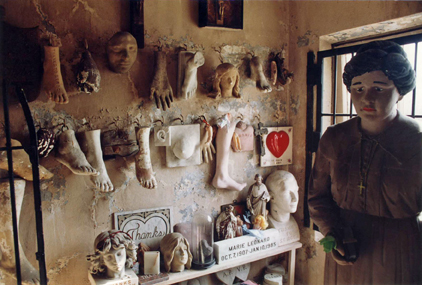
St. Roch Chapel (photo: Camille Martin)
Stepping into St. Roch Chapel in New Orleans feels like entering a shrine that isn’t quite real, like a movie set for the nineteenth-century yellow fever epidemic or a recreation of a voodoo shrine at an anthropological museum. I like to imagine that maybe it’s a place that is kept intact as a tourist attraction. I mean, does anyone still hang replicas of body parts on the wall of the chapel in gratitude to St. Roch for a miraculous healing? Or is it like the surreal gray moss dripping from crepe myrtle trees: something you suspect was hung there for the benefit of the tourists?
At places like this in New Orleans, it’s easy to feel as though you’ve crossed some invisible line and stepped into one of those parallel universes that string theorists talk about. The pennies and cockroach carcasses on the floor paved with bricks inscribed with “THANKS TO ST. ROCH” were sprinkled there by a movie director in the eighth dimension or a tour guide in the eleventh, to make the the place more convincingly reproduce the “authentic” dimension.
But no, it’s as real (or unreal) as the old ladies in Baton Rouge that I used to see praying to the statue of Huey P. Long on the grounds of the state capitol. And that reality is suspended in liminal space, trapped in a time capsule that seems as though it will always bear a close resemblance to whatever age in which its seal is broken.
I imagine sometimes that I feel nostalgic about living in New Orleans, especially when I rummage through my photographs, but really it’s mostly sadness that I feel, not a yearning to be there. St. Roch Chapel got about five feet of water. My neighbourhood was lucky. The area of Carrollton where I lived got only about two feet. I know many people whose homes were destroyed or heavily damaged.
But I didn’t leave New Orleans because of Katrina. Katrina only delayed my move to Toronto. There was a sickness at the heart of the city that caused me seriously to re-think living there. I could walk down my street and point to places where serious crimes had occurred: murder, rape, car-jacking, armed robbery. The racial tension was thick. Poverty, endemic. Public schools and other services, chronically underfunded.
I could easily turn this into a rant about the problems of New Orleans, pre- or post-Katrina. But I started off talking about the chapel. The tradition of placing a replica of one’s healed body part in a shrine or temple is at least as old as the ancient Greeks. There must be a lineage, a thread of tradition, that could be traced from those times all the way to St. Roch Chapel. Across the ages, the appeal to deities to be healed is ubiquitous. I suspect no one will ever put a replica of the city in the chapel, thanking god or saint for healing it. It’s a city whose inertia–whatever the cause–renders it in a state of constant deferral, steeped in nostalgia for what it perhaps never even was. When I think of the song “Do You Know What It Means to Miss New Orleans?” I can imagine it sung only in New Orleans. It’s when I was living there that I missed it.
Camille Martin
http://www.camillemartin.ca
I spent most of my life in Louisiana, and my grandfather on my Mother’s side was born there. But of course I had visited many times, and to me, the city–the real city, not the touristy parts–always seemed sad to me, as if decay was the best it could offer.
I thought your post was a lovely ellegy.
LikeLike
Hi, JC, and thanks. Yes, the city has been decaying for quite a while – from unethical landlords, Formosan termites and then Katrina. I prefer my sub-tropical Louisiana decay in the swamps.
Camille
LikeLike